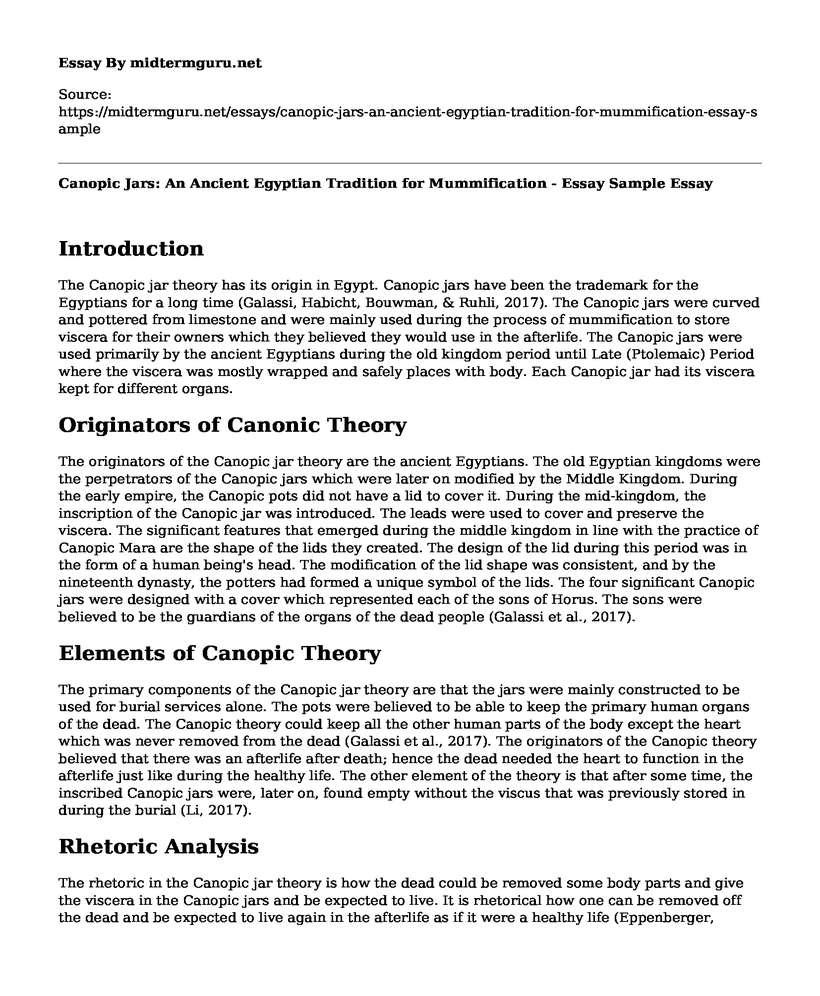Introduction
The Canopic jar theory has its origin in Egypt. Canopic jars have been the trademark for the Egyptians for a long time (Galassi, Habicht, Bouwman, & Ruhli, 2017). The Canopic jars were curved and pottered from limestone and were mainly used during the process of mummification to store viscera for their owners which they believed they would use in the afterlife. The Canopic jars were used primarily by the ancient Egyptians during the old kingdom period until Late (Ptolemaic) Period where the viscera was mostly wrapped and safely places with body. Each Canopic jar had its viscera kept for different organs.
Originators of Canonic Theory
The originators of the Canopic jar theory are the ancient Egyptians. The old Egyptian kingdoms were the perpetrators of the Canopic jars which were later on modified by the Middle Kingdom. During the early empire, the Canopic pots did not have a lid to cover it. During the mid-kingdom, the inscription of the Canopic jar was introduced. The leads were used to cover and preserve the viscera. The significant features that emerged during the middle kingdom in line with the practice of Canopic Mara are the shape of the lids they created. The design of the lid during this period was in the form of a human being's head. The modification of the lid shape was consistent, and by the nineteenth dynasty, the potters had formed a unique symbol of the lids. The four significant Canopic jars were designed with a cover which represented each of the sons of Horus. The sons were believed to be the guardians of the organs of the dead people (Galassi et al., 2017).
Elements of Canopic Theory
The primary components of the Canopic jar theory are that the jars were mainly constructed to be used for burial services alone. The pots were believed to be able to keep the primary human organs of the dead. The Canopic theory could keep all the other human parts of the body except the heart which was never removed from the dead (Galassi et al., 2017). The originators of the Canopic theory believed that there was an afterlife after death; hence the dead needed the heart to function in the afterlife just like during the healthy life. The other element of the theory is that after some time, the inscribed Canopic jars were, later on, found empty without the viscus that was previously stored in during the burial (Li, 2017).
Rhetoric Analysis
The rhetoric in the Canopic jar theory is how the dead could be removed some body parts and give the viscera in the Canopic jars and be expected to live. It is rhetorical how one can be removed off the dead and be expected to live again in the afterlife as if it were a healthy life (Eppenberger, Cavka, Habicht, Galassi, & Ruhli, 2018).
Importance of Canopic Jars in Artifacts Learning
Canopic jars are significant for objects learning. The Canopic pots enable the students to have a clear reflection of how the ancient Egyptians lived and how their burial practices were conducted (Li, 2017). Presence of the artifact in class during the learning process gives the students first-hand information on the Canopic jars. The actual observation of the ancient tools gives students a clue of the difference in the old life to the current dynamic life. The cultural practices of the Egyptians ate reflected through the Canopic jars which wen able the students to quickly understand the difference between the cultural lifestyle of the different communities (Li, 2017).
References
Eppenberger, P. E., Cavka, M., Habicht, M. E., Galassi, F. M., & Ruhli, F. (2018). Radiological findings in ancient Egyptian canopic jars: comparing three standard clinical imaging modalities (x-rays, CT and MRI). European radiology experimental, 2(1), 12. Retrieved from https://www.google.com/url?sa=t&source=web&rct=j&url=https://link.springer.com/article/10.1186/s41747-018-0048-3&ved=2ahUKEwi9ktj-oPjhAhVDXxoKHVVkARkQFjAAegQIAhAB&usg=AOvVaw0LUtR-04ofBR2HF1ysAuTB
Galassi, F. M., Habicht, M. E., Bouwman, A., & Ruhli, F. J. (2017). The Canopic Jar Project: an interdisciplinary analysis of ancient mummified viscera. CIPEG Journal: Ancient Egyptian & Sudanese Collections and Museums, (1), 75-79. Retrieved from https://www.google.com/url?sa=t&source=web&rct=j&url=https://journals.ub.uni-heidelberg.de/index.php/cipeg/article/viewFile/44165/37630&ved=2ahUKEwighsDjofjhAhVOThoKHVjgBHQQFjAEegQIBRAB&usg=AOvVaw1jpUO5SsCLSSpyECyr9vTK
Li, J. (2017). Women, Gender and Identity in Third Intermediate Period Egypt: The Theban Case Study. Routledge. Retrieved from https://www.google.com/url?sa=t&source=web&rct=j&url=https://searchworks.stanford.edu/view/11997687&ved=2ahUKEwjbveC5ovjhAhXK8OAKHY6xBioQFjALegQIBxAB&usg=AOvVaw2yU-_hEDgX23caozUJ6CFS
Cite this page
Canopic Jars: An Ancient Egyptian Tradition for Mummification - Essay Sample. (2023, Jan 09). Retrieved from https://midtermguru.com/essays/canopic-jars-an-ancient-egyptian-tradition-for-mummification-essay-sample
If you are the original author of this essay and no longer wish to have it published on the midtermguru.com website, please click below to request its removal:
- Essay on Mauritanias Legitimately Disallowing the Act of Slavery
- Taking Back the Schools Review Example
- Essay on Philosophy of Theodicy
- Social and Cultural Differences in Secondary Education - Essay Sample
- Personal Statement - Master of Art in Theology and Philosophy
- Christianity: World's Leading Religion With 31.5% of Global Population - Research Paper
- Changes & Growth From US Civil War: Government Reorganization & Economy - Essay Sample







